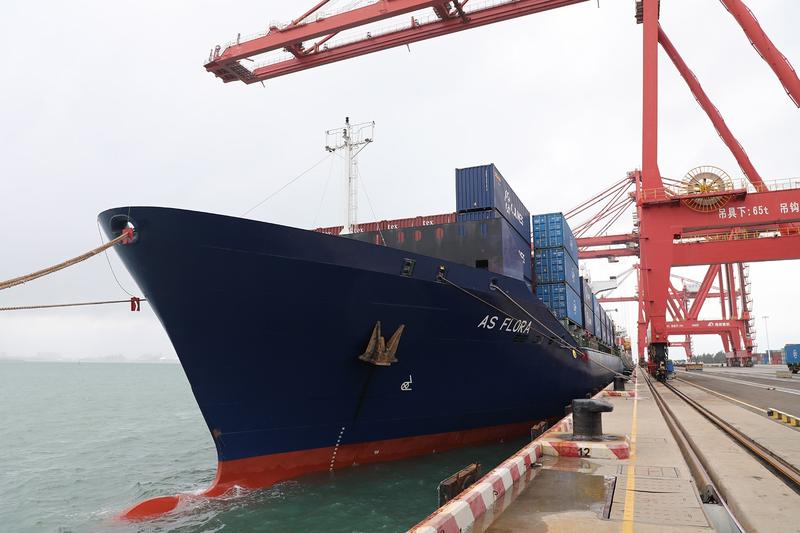 A container vessel leaves Yangpu Port, Hainan province, for Vietnam. (WU MAOHUI / XINHUA)
A container vessel leaves Yangpu Port, Hainan province, for Vietnam. (WU MAOHUI / XINHUA)
With many Southeast Asian countries resuming factory production as well as imports of more industrial intermediates from China, both shipping costs and trade volume between the two sides have risen significantly this year, exporters and forwarders said on Wednesday.
"March usually is the peak season for global clients to purchase summer accessories. However, we received many additional orders from Southeast Asia in the second half of this month," said Zhang Shengxian, an exporter of jewelry accessories based at Yiwu International Trade Market in Zhejiang province.
"The goods orders placed by our Southeast Asian clients have a distinct characteristic-demand for a short production and delivery cycle. We are desperately trying to catch up," Zhang said.
While shipping costs for a container shipped from ports in Shenzhen, Guangdong province, to ports on the west coast of the United States have dropped from the peak of $15,000 in the second half of 2021 to around $8,000 this month, it still costs a high $1,800 to ship such a box from Ningbo-Zhoushan Port in Zhejiang province to Port of Ho Chi Minh City in Vietnam.
The corresponding figure for shipping to Haiphong Port in Vietnam is even higher, said Ye Jian, vice-president of Ningbo Port Southeast Logistics Group Co Ltd in Zhejiang province.
The forwarder said that starting from the second half of March, shipment volume boomed on the routes connecting Ningbo-Zhoushan Port to ports in Southeast Asia, especially Vietnam. This caused freight rates to rebound gradually.
Before COVID-19, the average freight rate from China to Southeast Asia was between $300 and $400 per twenty-foot equivalent unit or TEU container. It had, however, risen tenfold to nearly $4,000 per box in mid-2021. Owing to sufficient shipping capacity, the price dropped to between $1,200 and $1,300 in January this year, data from the Beijing-based China Container Industry Association showed.
Because of the relatively short distance, it normally takes three or four days for a container ship to complete a voyage. Many shipping lines prefer to deploy small and medium-sized container vessels on the routes connecting China with member economies of the Association of Southeast Asian Nations.
Thanks to the complementary trade structure, ASEAN members' resumption of production has notably stimulated exports of China's industrial intermediates and commodities, including processing equipment and their components, textile yarn, motorcycles, clothing, refined oil, wires and cables, as well as other manufacturing parts.
Yu Genlai, head of the statistics unit of Haishu Customs, a branch of Ningbo Customs, said the city exported 5.8 billion yuan ($885 million) worth of goods to Southeast Asian countries in March, up 11.5 percent year-on-year.
During the same month, Ningbo's exports of high-tech products to the region increased by 80.1 percent year-on-year. Shipments of mechanical and electrical products, textiles, clothing and plastic products have all achieved double-digit growth, Customs data showed.
High complementarity in the industrial and supply chains, free trade deals at the regional level, and a new international land-sea trade corridor will continue to boost the close trade relations between China and ASEAN members in the coming years, said Zhang Jianping, director-general of the China Center for Regional Economic Cooperation in Beijing.
Trade between China and ASEAN grew by 8.4 percent year-on-year to 1.35 trillion yuan in the first quarter of this year. The region has reemerged as China's largest trading partner in March after the European Union surpassed it in the first two months of this year, data from China's General Administration of Customs showed. Ocean shipping activities between the two sides have been busy.
Cargo value generated by the China-Vietnam cross-border freight train services has more than tripled since the beginning of the year. This highlights wider trade between China and Vietnam and a stable supply chain for Southeast Asia as well, further enriched by the implementation of the Regional Comprehensive Economic Partnership agreement since Jan 1.
The Pingxiang Railway Port-the only cross-border railway port in South China's Guangxi Zhuang autonomous region-saw trade value reach 6.32 billion yuan in the first quarter of this year, up 240.7 percent year-on-year, data from Nanning Customs showed.


